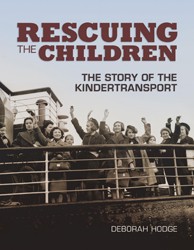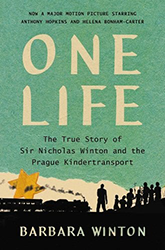Escaping the Nazis on the Kindertransport tells the stories of the 10,000 Jewish European children who were the beneficiaries of the pre-World War II logistical feat that rescued them from the horrors of the Nazis, sending them to host families in England. This book breaks down the big, almost unfathomable numbers into bite-size stories of those who benefited from the Kindertransport and those who organized it against all odds.
Eight chapters focus on individual children, describing their lives before, during and after the Kindertransport, making the now elderly, and often deceased participants’ stories current for today’s readers. First-person writing from Kindertransport participants, in combination with handwritten page numbers and family photos, make the book feel like a primary document.
The book goes into horrifying detail about specific indignations the children experienced during the rise of the Nazis, such as being kicked out of school, and includes photographs of European synagogues ignited by Nazis burning to the ground, Kristallnacht, and Jews being rounded up and arrested by Nazis.
There are also scenes of the mundane lives of the children before the Kindertransport that shows their parents’ jobs, their day-to-day lives, and their homes, evidencing that they were loved and cherished. One girl, Ursula Rosenfeld, whose father was arrested and later murdered by the Nazis, wrote of leaving her mother: “The parting was terrible. That’s the one thing I have never forgotten my whole life. And [my mother] had been so controlled. She’d always been a sort of solid support to us and suddenly she showed her feelings and it was terrifying, really terrifying. You saw this face that showed all the hurt and agony she’d been through… I would have liked to have had a happier image of my mother. That’s the only image, this contorted face, full of agony. It’s very sad.”
There are clear descriptions of the children’s emotions throughout the Kindertransport, their foster placement, and beyond: their terror, loneliness, and anger; their guilt for having survived when their parents did not, and gratefulness for the chances their parents took.
The final chapter describes the lives of Kindertransport children after the war. Many went on to pursue higher education, start businesses, marry and have children of their own.
Young readers will take away from this story that in the face of overwhelming horror, smaller, brave acts can change the course for many.
Additional resources in the book include a timeline, glossary, lists of additional websites and a bibliography. The publisher lists the book as appropriate for ages 8 to 12 but older readers may enjoy this book as well.
Dina Weinstein is a Richmond, Virginia-based writer.




